Change Comes To LFCA |
Read more
at in70mm.com The 70mm Newsletter |
| Written by: William Kallay | Date: May 7, 2004 |
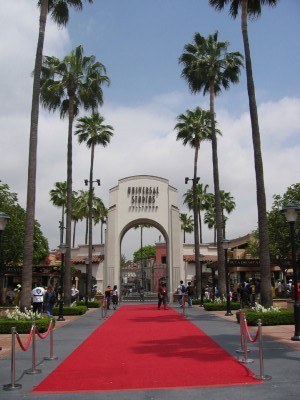 Universal
Studios Entrance Universal
Studios EntranceNo longer is it an issue of digital versus film, 2-D versus 3-D or tradition versus Disney. Instead, this year’s annual Large Format Cinema Association Conference (LFCA), held at Universal Studios in California, seemed to focus on change for the large format industry. Change was seen as a positive, not a negative. This year's theme was "The Business Of Large Format." |
Further
in 70mm reading: LFCA 2003 LFCA 2002 Internet link: bigmoviezone.com |
The Frank Marshall Connection |
|
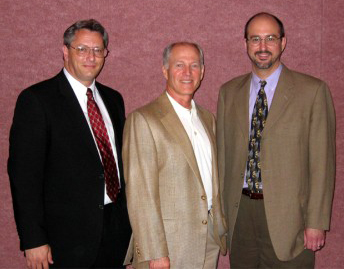 Left
To Right: Paul Holliman (Buena Vista Pictures), Frank Marshall and Left
To Right: Paul Holliman (Buena Vista Pictures), Frank Marshall and Robert Dennis (Technicolor/CFI) The keynote speaker this year was producer Frank Marshall. His extensive credits include "Raiders Of The Lost Ark" (1981), "The Color Purple" (1985), "Who Framed Roger Rabbit" (1988), "The Sixth Sense" (1999), "Seabiscuit" (2003) and the recent IMAX film, "The Young Black Stallion" (2003). The producer has been involved with large format since he spearheaded "Olympic Glory" (1999). On "The Young Black Stallion", he once again worked with large format cinematographer, Reed Smoot, A.S.C. The result was a stunningly filmed epic horse race in the desert, directed by Simon Wincer. Marshall is continuing to produce films for the large format screen. His company, Kennedy/Marshall, is working with NASA on a film called "Mars". Pictures from the recent Mars expedition are being beamed down to Earth and will be used in the large format production, directed by George Butler. |
|
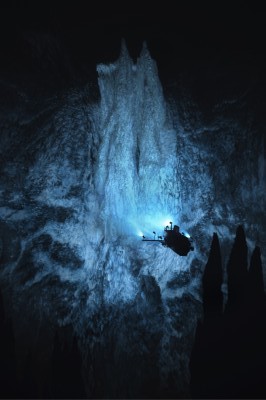 "Volcanoes
Of The Deep" "Volcanoes
Of The Deep"He did stress that he feels that the large format can be used to tell more "human" stories. He also stressed some ways of clarifying the differences between true IMAX and "faux" IMAX presentations. "I think that the way to do this is by making movies that were meant for the big screen and not by blowing up mainstream films and releasing them into the marketplace. I believe this is confusing the audience, as they cannot tell the difference between a movie “IN IMAX” as opposed to a movie “ON an IMAX screen.” For example, I have had several very upset friends who thought they were actually going to see the “The Matrix” that was actually shot in IMAX, not just blown up. This creates great disappointment when something is promoted as “ the IMAX Experience”, without delivering what people have come to expect. My big fear is that we are driving both filmmakers and the audience away." He had some comments about DMR, the practice of blowing up standard 35mm and 24p films up to large format. "The results of the DMR releases have been mixed, at best. My friends Ron Howard and George Lucas expected much more. But these results make sense to me. The movies were compromised and not shot or composed for the format, so why should they work just like the 35 mm versions? If Ron Howard or George Lucas wanted their films to be shorter; they would have cut them that way. I believe the poor showing of “Apollo 13” and the disappointing performance of “Attack of the Clones” is having a negative effect on mainstream filmmakers who might be interested in the medium and really hurts the possibility of future studio involvement. We cannot let DMR be the only way to provide more product. It’s the easy way out. We must all push for original product shot and presented in the traditional way people have come to expect from large format. That is the only answer." How does Marshall propose to improve the fortunes of the large format industry? "I truly believe it’s in the product. If you make good movies, they will come, and if they come, more screens will be built. It’s my hope to entice mainstream filmmakers like Jim Cameron, Simon Wincer, Fred Roos and others to push the envelope and create product that really moves the audience, as I know this format can." |
|
Disney And Digital |
|
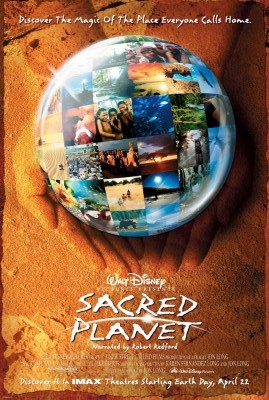 "Sacred
Planet" "Sacred
Planet"In contrast to previous conferences, delegates from all aspects of the large format industry were upbeat about the future of the format. With new digital technologies, such as High Definition cameras capable of 8K resolution and improvement in computer generated graphics, the large format industry has a number of tools at its disposal. Rather than shunning change, certain quarters of the industry have utilized those tools to bring large format films to audiences around the world. In addition, the industry has teamed with two major studios, Walt Disney Pictures and Warner Bros., to release films in the large format. The Walt Disney Company, as an example, is now seen as more of an ally than an “enemy.” When the company announced its plans to enter the world of large format with the release of "Fantasia/2000", many delegates were sceptical. Disney was seen as an outsider and mostly a commercial filmmaking company. But within the last couple of years, Disney has provided the large format industry with some hits, including “Ghosts Of The Abyss” (2003) and the 2002 reissues of “Beauty And The Beast”, and “The Lion King”. This is not to say that Disney has had a solid ride in this niche market. The beautifully filmed “The Young Black Stallion” has been a disappointment, earning about $6 million at the box office. But there are hopes that its recent release of "Sacred Planet" (2004) will bring audiences into IMAX theatres. |
|
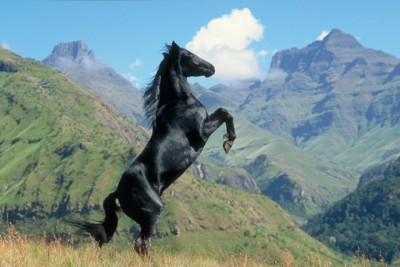 "The
Young Black Stallion" "The
Young Black Stallion"Besides the Disney connection, the LFCA Conference was abuzz with that magic word, “digital.” In the last five years, digital has been somewhat of a dirty word in the realm of 70mm film. Shoot on High Definition and blow it up to 15/70? Come on! Yet tests have been performed and have been presented to delegates almost every year. And each year, the quality of the images has improved. Once again, Olympus' 8K camera test was shown again in 15/70 and the results were very good. Another digital-to-large format blow up test was shown, too. Tests were performed on the new Viper Filmstream Camera. The camera shoots uncompressed high definition video on three CCDs that combine for 9.2 million pixels. The footage is then color corrected and filmed out to 15/70 print stock. The result on the IMAX screen is a good picture, but the imagery is soft. Where this camera shines is in its ability to capture nighttime images. Shots over the Los Angeles region were sharp and without noise. These are certainly not replacements for large format filmmaking, but they are extra tools that filmmakers can use. The new cameras and digital technologies were discussed in a day-long symposium on May 1, 2004, at the Entertainment Technology Center (ETC) in Hollywood. |
|
Film Festival Entries |
|
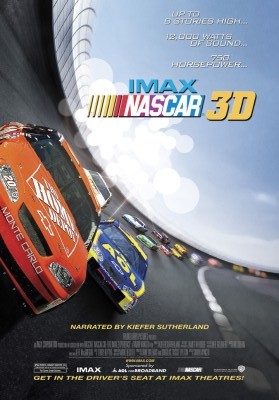 "NASCAR
3D" "NASCAR
3D"This year's entries at the conference ranged from traditional IMAX documentaries to the latest Hollywood large format releases. Features included "The Young Black Stallion", "Roar: Lions Of The Kalahari", "Virtual Actors", "NASCAR 3D: The IMAX Experience" , "Sacred Planet", "Volcanoes Of The Deep Sea" and "Forces Of Nature". Shorts included "A Better Mousetrap", "Stage Fright", and "Hubble: Galaxies Across Space And Time". "Roar:" Lions Of The Kalahari" was notable for its up-close shots of a lion king and his pride in Botswana. Director Tim Liversedge, true to National Geographic's photographic and story coverage of the wild, took the audience to the savanna to witness a lion's survival during the dry season. The film was mostly shot in 35mm. It is the first large format film to go through the digital intermediate process and the 35mm originated footage hold ups well in large format. The film was shown in a 1.66:1 aspect ratio. "Virtual Actors" is a combination of a CGI short called "The Boxer", and new material to bookend the piece as an educational film about computer generated actors. Two notable aspects about this film were its renderings of CGI actors and the new 96/24-bit DTS soundtrack. The virtual actors and animation is incredible. The actors are fluid and lifelike (though exaggerated in computer animation form). This is computer animation on par with Pixar. This was also the first film anywhere to use DTS' new 96/24-bit sound. DTS sound is very good in the large format as it is. But for audiophiles, the extra "breathing room" on the 24-bit soundtrack is pleasing. |
|
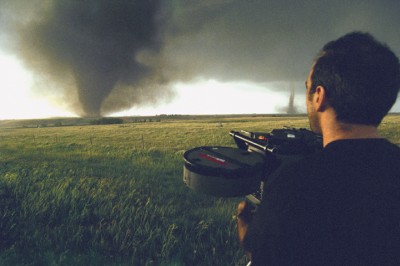 "Forces
Of Nature" "Forces
Of Nature"Director George Casey, who directed the wonderful "Amazing Journeys" (2000), helmed "Forces Of Nature". This film, though mostly complete, was shown in 15/70 with a temporary 35mm magnetic track. Tornados, earthquakes and volcanos are featured in this film. In fact, Casey and his crew caught footage of a volcano's sudden eruption. The film won the LFCA's Best Of Festival Feature Award, and "Hubble: Galaxies Across Space And Time" won for Best Of Festival Short. |
|
Stephen Low Honored |
|
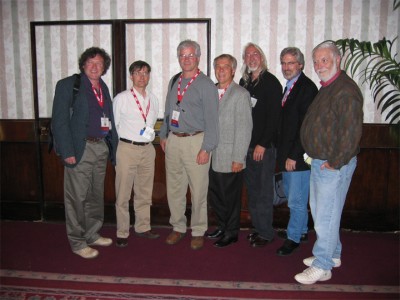 Left
To Right: DPs Dominique Gentil, Sean McCloud Phillips, David Left
To Right: DPs Dominique Gentil, Sean McCloud Phillips, David Douglas, James Neihouse, Rodney Taylor, Reed Smoot and writer Bob Fisher Though I wasn't able to attend the Kodak Vision Award Ceremony, I was pleased to hear that filmmaker Stephen Low was the recipient this year. He was the director and producer of "Super Speedway" (1997), which not only has some great racing footage, but one of the most dynamic soundtracks in an IMAX film. He's also directed and produced other notable large format films like "Across The Sea Of Time" (1998), "Titanica" (1995), "Beavers" (1988) and the recent "Volcanos Of the Deep Sea" (2003). His father is a past Kodak Vision Award winner, Colin Low, who directed the multimedia classic, "Labyrinth" (1967), and his brother, Alex, is a producer and writer in large format. |
|
Large Format Discussions |
|
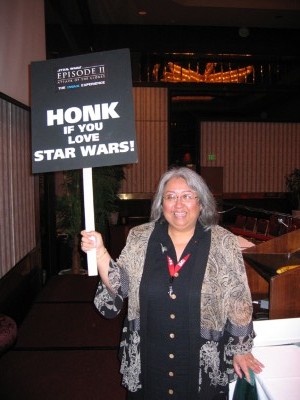 Diane
Carlson of the Pacific Science Center, Seattle, WA Diane
Carlson of the Pacific Science Center, Seattle, WAThere were a number of discussions about cinematography in large format, funding and marketing at the conference. It was felt by some, as in other LFCA Conferences, that the large format industry still has its work cut out for itself in getting films into the public's eye. Many IMAX films simply do not perform well at the box office. This constitutes, with very low advertising budgets among exhibitors in large format, using clever marketing. Diane Carlson, who heads the IMAX theaters at the Pacific Science Center in Seattle, devised clever and inexpensive marketing for her venue. For example, she's used people dressed up in "Star Wars" costumes to visit various locations in Seattle for the opening of "Star Wars: Attack Of The Clones-The IMAX Experience", The end result was a lot of free press and people in theater seats. But for others, marketing means something different. "Title is king," said Toby Mensforth of the Smithsonian. He said that "To Fly" , a 27 year-old film, is still playing at the museum! Other films like "T-Rex: Back To the Cretaceous" (1998) is another example of a good title that draws in audiences. He went on to explain that IMAX is still not a familiar name with the public. Audiences seem to know of a title like "T-Rex" , but not the format it's in. |
|
IMAX Goes Hollywood |
|
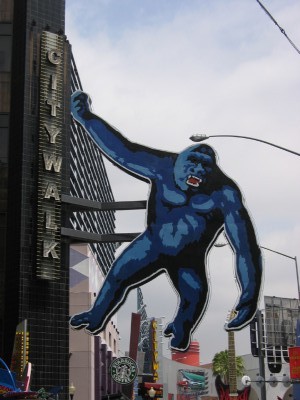 As
it's been announced, "Harry Potter And The Prisoner Of Azkaban" and
"Catwoman" are slated for day-and-date release in both 35mm and
IMAX this summer of 2004. Warner Bros., which has had success with
"NASCAR 3D", is continuing its alliance with IMAX by releasing
these 35mm productions via the DMR process (Digital Remastering). As
it's been announced, "Harry Potter And The Prisoner Of Azkaban" and
"Catwoman" are slated for day-and-date release in both 35mm and
IMAX this summer of 2004. Warner Bros., which has had success with
"NASCAR 3D", is continuing its alliance with IMAX by releasing
these 35mm productions via the DMR process (Digital Remastering). The great news is that "Harry Potter", according to Patricia Keighley of DKP 70mm, Inc., will be converted to IMAX from the original digital files, and not scanned as previous DMR releases have been done. This will mean that picture will be extra sharp and detailed. The consensus among delegates who saw the preview of "Harry Potter" is that the picture quality looks very good. And according to www.bigmoviezone.com, "Polar Express" is slated for the IMAX screen. |
|
Overall Impressions |
|
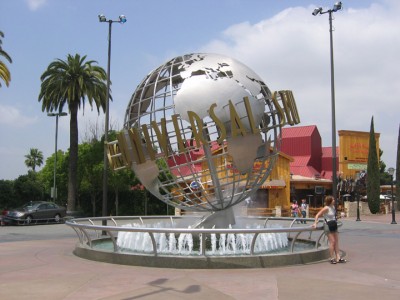 Universal
Studios Entrance Universal
Studios EntranceThis year's conference was relaxed, more than any other year in recent memory. Former "enemies" have become important allies, like Disney and now Warner Bros. Digital technology has been embraced by more large format filmmakers as another tool to work with, rather than a replacement for large format filmmaking. Yet, some things haven't changed. Much of the public still isn't aware of what IMAX really is and can be. Is it an "enhanced 35mm print?" And what does an "enhanced 35mm print" mean anyway? A potential customer at an IMAX theater might complain, "I've seen IMAX before. Why doesn't "Harry Potter" fill the entire screen?" Or, as some at LFCA made comments about, "If I see another IMAX film about sharks or coral..." On one hand, the large format industry has done a superior job in keeping the institutional market alive with some excellent large format films. On the other hand, the industry has struggled to forge an identity with the public. As it has been in year's past, much of the public may remember seeing an IMAX film, but it's usually within the caliber of a big hit like "Everest" or "Fantasia/2000". Many other well made films fall by the wayside and barely register with those same paying customers. |
|
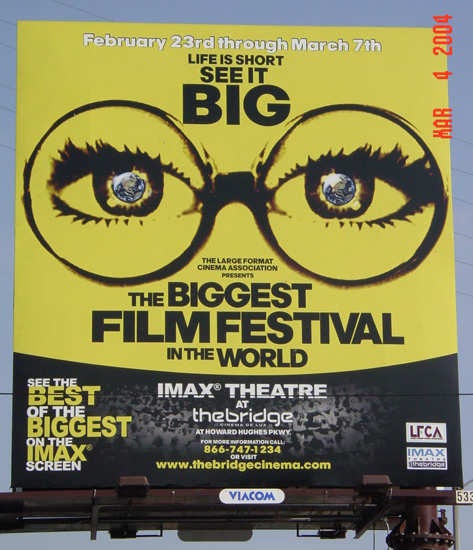 As for the commercial markets, the large format industry and their major
studio partners have to give audiences something special to see. A few years
ago, there were plans for a
"Star Trek" film in IMAX. But after those plans fell through,
there hasn't been another franchise film to take its place. It's been proven
that audiences will see short films, as evidenced in some theme parks, again
and again if they're given something worthwhile to see. The same could hold
true for a selection of large format films from the commercial world of
moviemaking. As for the commercial markets, the large format industry and their major
studio partners have to give audiences something special to see. A few years
ago, there were plans for a
"Star Trek" film in IMAX. But after those plans fell through,
there hasn't been another franchise film to take its place. It's been proven
that audiences will see short films, as evidenced in some theme parks, again
and again if they're given something worthwhile to see. The same could hold
true for a selection of large format films from the commercial world of
moviemaking. As for the confusion over what IMAX or large format is, the paying public should be educated on the differences between DMR, enhanced 35mm prints and IMAX. This could be done inexpensively and in an easy enough way that they will understand. Otherwise, they will continue to be confused. There is hope on the horizon. Both Frank Marshall and James Cameron are producing new films for the large format screen. Box office returns on "NASCAR 3D" have been promising. It seems that for the first time in a while, the large format industry is realizing that change can be a good thing. Change is happening in large format and hopefully, for the positive. |
|
 Hubble:
Galaxies Across Space And Time Hubble:
Galaxies Across Space And Time |
|
|
|
|
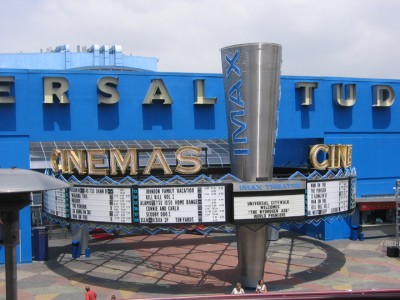 Loews
Cineplex Universal Studios Loews
Cineplex Universal Studios |
|
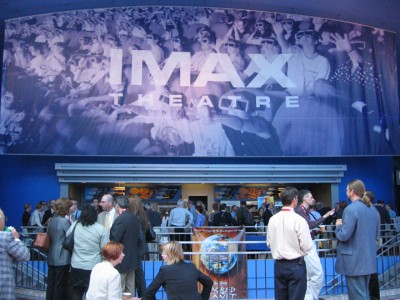 Members
Meet In Loews Lobby Members
Meet In Loews Lobby |
|
|
Go:
back
- top -
back issues
- news index Updated 22-01-25 |
|

 Members
Of LFCA Meet At The Hilton
Members
Of LFCA Meet At The Hilton